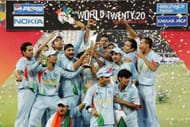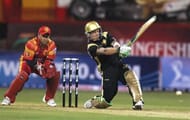1877 and 1971. Two random years. No connection between them, nothing at all. Except one little thing. These are the years which gave birth to the the first two formats of a sport called Cricket. 1877 was when Test Cricket started. There were only two teams playing it back then, England and Australia.
As time progressed, other teams started coming onto the International scene. West Indies came, South Africa came, New Zealand came, India came. The sport was growing. The teams were few, the matches were few, those playing the sport in these countries were few, but they were increasing gradually. Cricket was becoming more popular. Cricket was growing.
Cricket, then, was not time bound. Matches carried on, for days and days, until there was a result. The game was a product of it’s surroundings. The matches were long and slow. There is a reason for that. It was due to the pace of life back then. People had a lot of time, they could watch matches spread over days, their life was not as hectic as it is now. So, Test Cricket flourished. And the people started loving it. It’s popularity kept on increasing, those wanting to play it kept on increasing.
Test Cricket continued as the sole format of the game until 1971. This was when One day international (ODI) cricket began. With life becoming more fast paced, people had less time to indulge themselves in watching a sport spread over 5-6 days. The number of people flocking to the stadium to watch matches reduced, those listening to commentary on the Radio reduced. People didn’t have the time, didn’t have the energy to follow long and slow games.
To counter all of this, ODI cricket began. It was shorter, it was faster and it was more appealing to a larger section of the population. The matches were supposed to end in one day, with each team batting for a maximum of 60 overs(later reduced to 50 overs). Runs were scored at a faster rate, the dull periods in a match were lesser, it was more exciting and it didn’t take much time.
This format helped cricket in many ways. It attracted new spectators, it attracted newer countries to play the game, it attracted major companies to invest in the game, it attracted money, a lot of it and it gave rise to the first global cricketing event, the World Cup. With the expansion of ODI cricket, the game grew much more and much faster than ever before. It seemed that this would be the format that would continue Cricket’s expansion, that this would be the format that would bring in newer spectators, newer countries, that this would be the format that would bring in money to the game, that this would be the-the format that everyone will have the time and patience to watch. It did all of that, but only for a limited period of time, much lesser than what was expected
By the early 2000’s, even 50 overs seemed too long. There was a lot of unnecessary, boring cricket going on, the excitement of ODI’s had disappeared, it was not attracting newer people, the stadiums were rarely packed, the television ratings fell, the interest levels fell, the game stagnated. Much like ODI’s in the 1970’s, the game needed a new format to spread it to other parts of the world, to make it more appealing to the people, to attract more money, to help it grow even more. In 2003, England introduced that new format. They called it Twenty20 cricket.
T20 Cricket - It’s beginning in England
The year is 1998. The England & Wales Cricket Board is worried. The attendance at the county matches is dwindling. The Benson & Hedges Cup is not attracting people. It is not attracting sponsors either. They are not earning money through ticket sales, nor through sponsorships. They need to do something to revive their domestic cricket. They propose a new 20 over a side format. The MCC laughs at it, rejects it. So do the counties. The ECB forget about it. The attendance drops even further, so do the sponsorships.
The ECB brings up the idea again. In 2001. This time, they are more resolute. They invest £200,000 in market research. The studies show that two-thirds of the population don’t have any interest in cricket, but half of them would be able to tolerate shorter matches played during the evenings. The ECB take this study to the counties and the MCC and it is approved. Twenty20 cricket is born. The year 2003 can now be added to 1877 and 1971.
This is not looked at as an important form of the game. The aim is for it to be fun, with cheerleaders, good food, alcohol, loud music. It is supposed to be like a picnic, like a family outing, where even those who don’t follow the game come to have a good time. It is not meant to be serious cricket. It is not. The administrators don’t treat it that way, the spectators don’t treat it that way, the broadcasters don’t treat it that way, the players don’t treat it that way. But it is a major success. The ticket sales increase phenomenally, the stadiums are packed, the television ratings touch new highs, sponsors are attracted to it, they make larger investments, the broadcasters earn higher revenues from advertisements, the players earn more money, they are happy, the spectators are happy, the administrators are happy, everyone is happy.
In the next five years, Twenty20 cricket brings about a revolution in the way the game is played. The success of the format in England is followed by it’s introduction in Pakistan, Australia and the West Indies amongst others. The year is 2006. And all of these countries have T20 tournaments of their own. They are carried out like the first-class matches or the domestic one-dayers, with state teams or counties playing against each other. All of this is about to change. The T20 World Cup scheduled for 2007 changed cricket forever.
The first T20 international was played in 2005. It was Australia taking on New Zealand. It did not feel like an international match. Both teams wore jerseys that resembled the ones they wore in the 1980’s. Some of the New Zealanders even wore wigs and fake moustaches in an effort to recreate the retro look. Glenn McGrath bowled an underarm ball. The umpire Billy Bowden issued him a red card. This was not real cricket. But in the space of a few years, it changed Cricket.
Impact of the 2007 T20 World Cup
March 2007. India crash out in the group stages of the 50 over World Cup in the West Indies. This is a big deal. There is a huge uproar in India. The players’ houses are attacked, their effigies are burnt. India has gone berserk. Greg Chappell is sacked. The players’ heads are called for. Accusations of match fixing are rife.
September 2007. The T20 World Cup begins. India come in to this tournament having played all of one T20 international. Their first match is a washout against Scotland. The second one against Pakistan ends in a tie. India win via a bowl out. In the Super8 stage, India lose their first match against New Zealand after scoring over 200 runs. In the next match against England, Yuvraj Singh smashes six sixes in an over. The cricket loving population of India goes crazy. Yuvraj wins millions of new fans. The match against South Africa is a must win game. India’s bowlers win it for them. RP Singh takes 4 wickets, Dinesh Karthik, one of the best catches in the history of the game. India face Australia in the semi final. Yuvraj scores a 30 ball 70. Australia are thrashed. The popularity of the format skyrockets in the space of two weeks. India has fallen in love with T20 cricket, so have the administrators and the businessmen, sensing something very big. While India prepares to take on arch rivals Pakistan in the final in Johannesburg, plans are being made to launch two T20 leagues in India.
The Zee Entertainment Enterprises(ZEE) is about to launch the private Indian Cricket League(ICL), while businessman and sports administrator Lalit Modi is coming up with the idea of a BCCI run Indian Premier League(IPL).
As India wins the final, the joy amongst the people of the country is unbelievable. This victory makes up for the early exit in the 50 over World Cup. It makes up for the numerous losses India had faced in the recent years. It makes up for the fact that India had not won an ICC event for 24 years. It makes up for it all.
Lalit Modi is there at the stadium, smiling when India takes the last Pakistani wicket. He knows how cricket is going to change in the next couple of months. He knows that he’s the man who is going to change cricket. He knows that the IPL, his brainchild is going to change cricket. He knows that the T20 World Cup, which seems so big right now, will cease to matter, will not be given any importance in the coming few years, once the IPL takes off. He knows that the ICL will fail, for he will use his might to get it classified as a rebel league. He knows that the IPL will not face any competition. As he applauds the Indian team, he knows all of that.
T20 cricket in India - The ICL and the IPL
The ICL started in late 2007. It didn’t turn out the way ZEE had imagined it would. There were no star players, there was not much hype, there was not much money, there was not much to write home about. The BCCI had declared it as a rebel league, banning anyone who joined it from playing the Ranji Trophy, thereby disassociating them from Indian Cricket. A few players, those who knew they wouldn’t play for India, those who wanted some financial stability joined, but it never really took off. It never reached the heights it was expected to and was scrapped in 2009, after just two seasons.
The IPL, thus was without any competition when it was launched. It was the one single event which revolutionised the game of cricket. Cricket became more than just a mere sport. It became a business, it became an industry, it became something which had to be marketed. It had to, because of all the money involved, because of the kind of people involved in it. The owners, who invested hundreds of crores in buying their franchises, ranged from Bollywood actors to business tycoons and corporate companies. When sport is not looked at as just a sport, the players are also not looked at as just players. They became entities, who were bought and sold in the auctions. And they were paid a hell of a lot of money, amounts which had never been heard of.
Everyone loved it. As IPL 8’s slogan says, it became a festival in India. People, young and old, girls and boys, rich and poor, were all brought together in a way never seen before. Stadiums were packed, the television viewership was breaking all-time records, the amount of investment made by companies was humongous, the revenue earned through advertisements was extremely high. The IPL had everything going for it. It succeeded, financially or in commercial terms, like no other event in cricketing history had. It has had eight seasons until now and the craze hasn’t diminished. The fourth season, immediately after the 2011 World Cup was the only one that has failed. It’s been that successful, just one failed season in eight.
The success of this tournament has given rise to various IPL style leagues around the world. Australia, South Africa, Bangladesh, Sri Lanka, West Indies, England, Pakistan have all come up with leagues of their own.
If you compare football with cricket, you will find one striking difference. In football, a lot of importance is attached to club games, much more than International matches. Whereas, in cricket, clubs didn’t exist until the IPL came about. International cricket was all there was.
There’s a reason more people watch football. Matches get over in 90 minutes flat. One dayers take 420. What the IPL is doing is basically making the game easier to promote by following the football model. T20 internationals do not have much importance now. It’s mostly just the IPL’s and the Ram Slam’s that people talk. The frequency with which the T20 World Cup takes place has greatly reduced it’s importance. On the contrary, the infrequency of bilateral T20 internationals suggests the fact that it is not looked upon as a viable option. The club matches are played in the evenings, only last for three hours, the batsmen slog, the crowds are entertained and a lot of money is made. T20 is the first format in which domestic, club games are given more importance than Internationals. It’s clear that this is the beginning of the ‘footballisation’ of the game. T20 affords us that luxury. ODI and Test Cricket, not so much. Not much at all.
There’s a reason to adding 2003 or 2008 to the list containing the years 1877 and 1971. 2003 should be added because it was when T20 cricket started. 2008 should be added because it was when club cricket started, it was when club cricket became important, it was when the game got revolutionised. 2005 not so because it contained the first T20 international. In the present context, it’s not of much value, is it? That’s how far T20 has come. That’s how far T20 has brought the game. It has made club games more valuable than internationals. It’s just the beginning. There’s a lot more it can do. Once that is achieved, something else will come up, and this cycle of change will go on.
Follow IPL Auction 2025 Live Updates, News & Biddings at Sportskeeda. Get the fastest updates on Mega-Auction and cricket news




